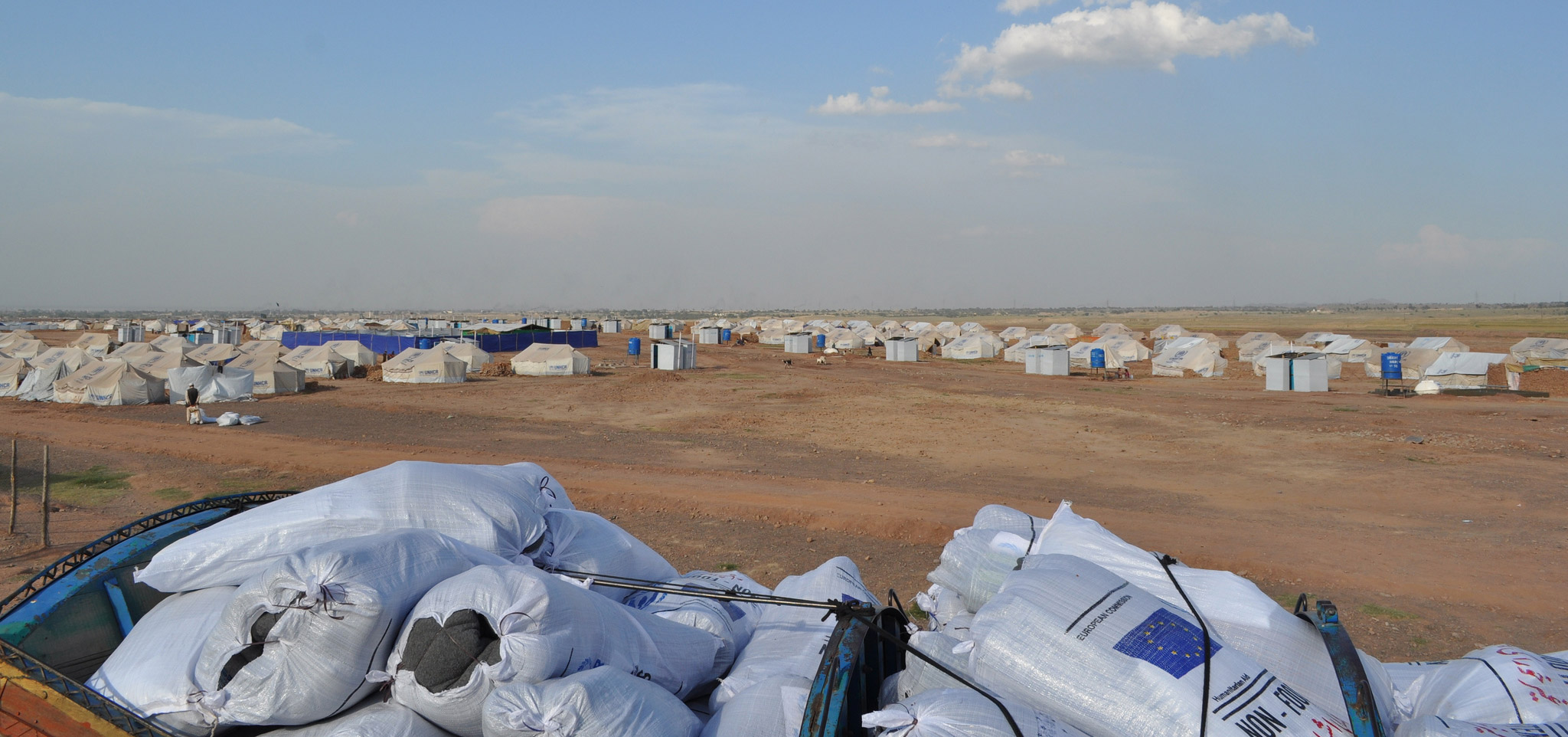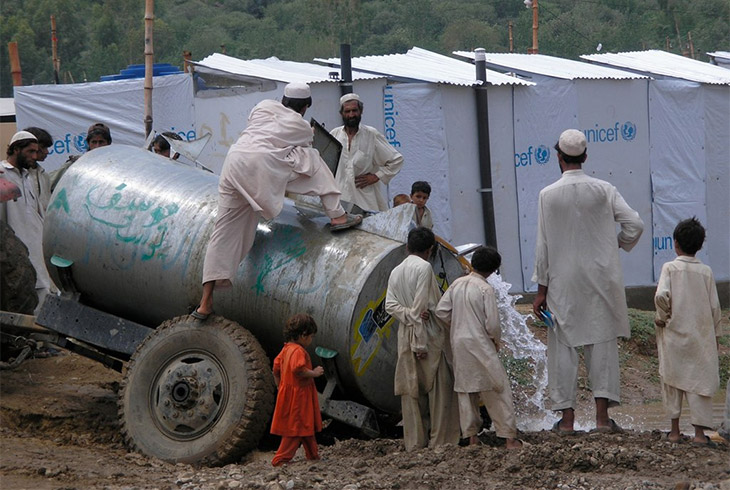Cultural insensitivity in handling of IDPs
In this regular blog, researched and commissioned by CRJ’s Pakistan correspondent Luavut Zahid, Hurmat Ali Shah – a freelance columnist and PhD candidate – looks at the issues facing Internally Displaced Persons in Pakistan.
According to the UNHCR, Internally Displaced Persons (IDPs) probably constitute the largest group of vulnerable persons in the world. The term IDP – “the soulless shorthand of bureaucracy” – is a confusing term with no strict definition, let alone clear defined rights for those labelled IDPs. According to a UNCHR study, IDPs outnumber refugees by two to one, yet they receive much less global attention.

IDP camp in Pakistan (Photo: Tariq Malik | Oxfam)
Being denied basic human rights like shelter, education, food and water and access to a clearly-defined legal framework, the plight of IDPs is compounded by this lack of global attention. Often, they are not prioritised by international aid organisations and can sometimes be viewed as ‘messy’ beneficiaries, with no visible needs or tangible targets. This is because most IDPs prefer urban settlement rather than formal camps. This is illustrated by the case of displaced people from the North Waziristan Agency (NWA) where less than ten per cent of IDPs have opted to stay in designated camps.
Pakistan stands out as unique in a sense that for the greatest part of the previous decade, and for the whole of this decade, IDPs from one region or the other have been present in urban settlements or IDP camps. Military operations against militants have resulted in the continuous flow of IDPs from 2006 onwards. The military offensive in 2007 in South Waziristan Agency (SWA) saw the first mass exodus of IDPs, while the operation in Swat in 2009 opened the floodgates for IDPs. Indeed, it was estimated that there were around two million displaced persons from Swat and the whole Malakand division.
The current offensive against militants in the NWA has resulted in the mass migration of people from and the number of IDPs families from NWA is 94,152 with almost half of them comprising the most vulnerable element of Pushtun society – women.
The plight of IDPs is further aggravated in case of Pakistan where IDPs are from socially conservative tribal areas of north-west part of the country. The social life and to large extent the personal behaviour of these people is guided by Pushtunwali, an unwritten customary law and code for conduct. The identity and self-imagination of Pushtuns at large, and of people from conservative FATA in particular, is closely tied to and defined by the percepts of Pushtunwali. This code is a lived experience, always present in folklore, poetry, anecdotal tales, moral percepts and ethical values, and thus this code permeates every confine of the social order. Honour, hospitality, dignity, Nang (standing-up and coming to the rescue of friend, ally, family member or any other person to whom protection is pledged), Pat (loosely translated as pride), Jirga (a council of elders for arbitration), Makh (the binding nature of Jirga or request of an elder or family member) and revenge, are basic constituents of this code.

Photo: Patrick and Martha Dundon via Flickr CC
The legal rights and laws of Pakistan are not extended to FATA, neither do Pakistan superior courts have jurisdiction over there; the region is instead run through Frontier Crimes Regulation (FCR), a British era administrative and criminal penal code. It makes perfect sense that the people from FATA will abide by Pushtunwali in the absence of a modern legal and judicial framework.
The personal space and sanctity of home are sacred entities in tribal social structure, no-one in any circumstance violates the Purdah or segregation of females from the glance of males. Given these strict – albeit discriminatory to women – practices and the proud self-imagination and self-conception that the notions of honour and Nang and Pat, instil in tribal and Pushtun men, the phenomenon of becoming an IDP exerts a toll that is psychological, social, emotional and cultural beyond material and physical.
All these factors combine to morph into emotional distress and identity crisis for the IDP. Physical and material wealth are somewhat compensated for by the national government by assistance of international aid organizations but the emotional pain and de-personalization and de-realization and identity dislocation are inaccessible to the authorities and they sometimes unconsciously, through their complete lack of sensitivity to the culture of the displaced people, either initiate the process or worsen the crisis of self-imagination and self-perception.
Probably the singular contributing factor to identity dislocation and de-realisation is the compartmentalisation of identities by the authorities. Restrictions on freedom of movement and stereotyping the tribal people by their particular looks and attire lower the self-esteem of IDPs. While long hair and beards and a piece of cloth (Chadar) hanging on their shoulders may be symbols of identity for militants in a settled area like Swat, they are also common attire in places like NWA in FATA.
The humiliating treatment extended through indefinite waits in long queues at check-posts and then demanding legal documents manifests not only the fact that all tribal people are considered suspects, but at the same time, betrays unawareness of globally recognised phenomenon that losing LINK documentation is the norm in such situations.
The other problem faced by IDPs from FATA and other Pushtun areas is that the checkposts are manned by soldiers that speak languages other than Pushto, mostly Urdu. The IDPs are therefore unable to communicate with personnel at check posts. The long wait at queues for security checking, lack of documentation and inability to communicate initiate a sheer sense of humiliation which is aggravated as security checking for IDPs from areas affected by militancy is recurring process, often repeated daily at the entrances to IDP camps and often in cities in whose suburbs the camps are established.
Violation of sacred code of Purdah and the sanctity of personal space adds more to the emotional distress and identity dislocation of IDPs. Women from FATA are unexposed to the external world and are the most vulnerable to emotional distress and PSTD in these scenarios. These women, or at least those who are uneducated and come from religiously conservative families, have internalised the patriarchal concept of Purdah, although to their own loss. According to one researcher6, women have refused to go to the food distribution point and be in the gaze of unrelated males as it makes them feel violated. Inexperienced Pushtun women who rarely set out foot out of their house are made to wait in long queues and deal with men to get their rations. The structure of camps does not offer lock systems, so the very basic intimacy of families is violated3.
The emotional distress and identity crisis are compounded by the taboo of seeking out psychiatric health in Pakistan. No psychiatric counselling is available at the IDP camps. Researchers have recorded accidents of insomnia in female IDPs from militancy-hit Waziristan. Women are so disturbed as to be sent into panic even at the sound of a firecracker7. Their insecurity as regard to the future, displacement from their homes, disruption of income and meting out of a treatment that is insensitive to their culture, are aggravated even further by a lack of access to proper psychiatric counsel.
The authorities can do much to prevent spiralling of the identity crisis and de-realisation and emotional distress of the IDPs. The long queues for security checks could be replaced by intelligence-based searches of the displaced people. The soldiers and personnel that communicate with IDPs should be native language speakers. Proper care should be taken to avoid treatment with IDPs that reflect stereotyping based on common kinship and similar appearance to the militants.
Cultural sensitivity training should be arranged for the management of IDP camps and unnecessary strolling of the area in the camps where the families reside should be banned. To avoid inflicting humiliation, multiple food distribution points should be established. Finally the emotional and psychological health must be taken care of, because being IDP can be a once-in-a-lifetime occurrence, but the emotional pain and de-personalisation and identity crisis that it can engender is a lifelong tribulation.
Sources
-
Protect or Neglect: Toward a More Effective United Nations Approach to the Protection of Internally Displaced Persons, Simon Bagshwa and Diana Paul, 2004;
-
Alexandra Fieldan, Ignored displaced persons: the plight of IDPs in urban area, New issues in Refugee Research, Research paper No. 161;
-
The crisis of Internally Displaced Persons in the Federally Administered Tribal areas of Pakistan and their impact on Pushtun women, Zkia Rabab Mohsin.
-
Photo: Tariq Malik/Oxfam
Hurmat Ali Shah is a freelance columnist and PhD candidate. His work primarily focuses on society, politics and culture. He places an emphasis on the political and social issues present in Pakistan
Luavut Zahid, 15/06/2015